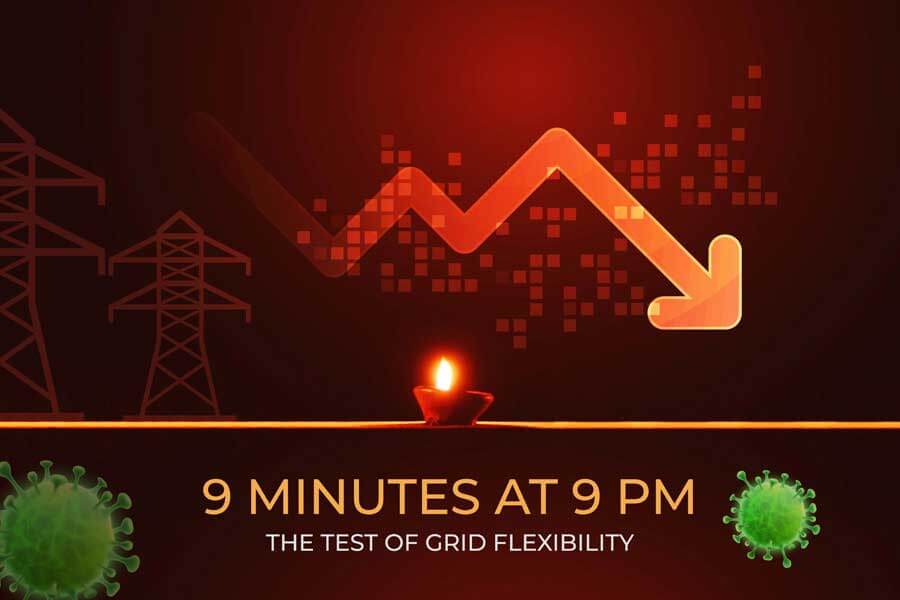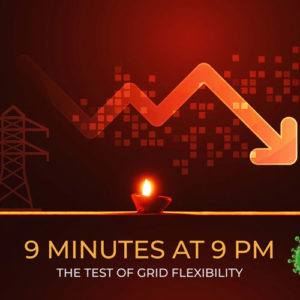9 minutes at 9 PM: The test of grid flexibility


It doesn’t take much power to light a single bulb. But when you have billions of lights, the story is not the same. When all the households shut down their lights for 9 minutes at 9 PM, it was expected to cause a power swing of 12-15 GW on India’s grid. The total power reduction on the night of 5th April 2020 was 32 GW, twice of what was anticipated. As the lights came back on, the power demand shot up by 26 GW again. In a fraction of an hour between 20:45 to 21:45, the electricity demand came down from 117 GW to 85 GW, and increased to 111 GW again. It can be said that Indian power system successfully underwent a litmus test of its flexibility on the night of 5th April. While the feat is remarkable in itself, the event opens a window to reflect on grid flexibility i.e. the ability to respond to changes.

Maintaining Supply-Demand Equilibrium
One of the foundational principles of operation of electricity grid is the balance of supply and demand at every instant. Any mismatch between supply and demand can wreak havoc in the electricity grid and lead to blackouts. To achieve ‘9 minutes at 9 PM’, the grid operators required a strategy to ensure that the grid does not collapse due the sudden changes. During the unprecedented event of demand reduction, the system would undergo a drastic change in power generation to match the load change. The grid operators needed to ensure that they had enough flexibility resources in their arsenal.
Power system flexibility is a hot topic of discussion in India as the bulk of the legacy grid comprises of coal-based thermal power generation. Coal power plants are designed as baseload plants and there are inherent challenges in getting coal plants to respond quickly to changing demand. Hence on 5th April, the generation from major coal plants was gradually reduced to the minimum possible limits before 9 PM. The flexibility of 7 GW was obtained from operating coal plants at their technical minimum.
Hydro the Hero of the day
The real hero that saved the day is hydro-based generation which pretty much followed the changes in the demand curve to the dot. Hydro by itself accounted for 18 GW of the generation reduction in a span of 25 minutes. Hydro-based generation dropped Hydro plants also helped in quickly turnaround of the grid by increasing generation by 10 GW power in the next 12 minutes. Pumped storage hydro units also came online in storage mode from 20:45 hours to absorb the extra generation from the sudden lighting load loss.
Gas-based generation units designed for meeting the peak load also came quite handy in flexible operation. It was also interesting to observe that flexibility obtained wind generation matched the flexibility from Gas generation. Both of these resources together provided a flexibility of 4 GW in India.

Lockdown Lows leveraged
There is no doubt that generation flexibility measures were the need of the hour in India. It should not be forgotten that on 5th April, the grid demand was already lower by 25% due to the lockdown. A sudden change in demand would have been more complex to contain with supply-side measures alone if the demand was high enough. That is, if the event had coincided with what would have been summer peak load in India, it is quite possible the adoption tactic of generation flexibility might not have been enough. This is because while handling large scale events, transmission and interconnection bottlenecks can often lead to underutilisation of generation flexibility options.
Flexibility is the future
But the answer to the power system operation problem is not limited to flexible generation alone. Cost-effective and reliable system operation can be achieved from distributed resources as well. Many of the demand side flexibility options such as energy storage and demand response have not received any attention from the grid operator. These resources have the potential to provide system flexibility services at the local level and bulk level if aggregated, as was needed on 5th April. It is counterproductive to neglect demand flexibility as distributed energy resources are expected to grow significantly in India in the coming years.
This blog has been drafted by Senior Research Associate, Chandana Sasidharan.




